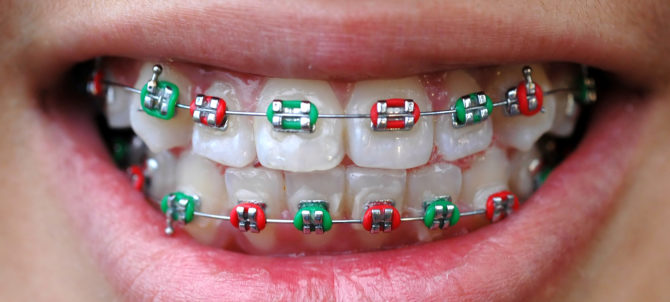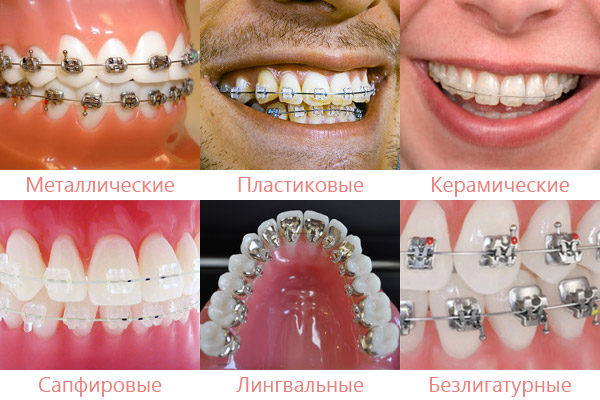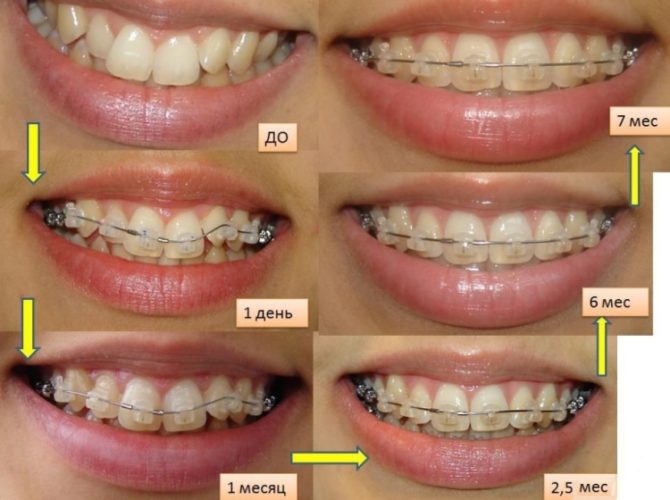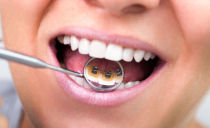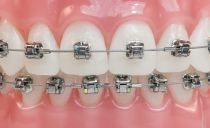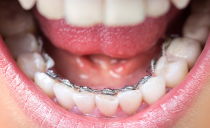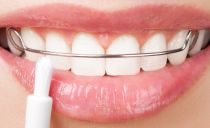From what age and up to how old can braces be placed to align teeth
Problems with the formation of a permanent dentition occur in many children. Attentive parents who are trying to help the child avoid any physiological and psychological problems constantly consult with a child’s orthodontist. And when revealing a malocclusion or a slight curvature of the teeth, they first of all ask the question of how many years you can put braces on a child, and at what age the correction of the dentition is most effective and successful.
Content
Indications for installing the bracket system
Dentists recommend that patients wear braces if they have:
- Malocclusion.
- Large gaps between the teeth.
- Crowded teeth.
- The lower and upper jaws develop inconsistently.
- One or more teeth have an irregular position and shape.
- There are problems with chewing function.
With an increased likelihood of defects in the dentition, parents should pay special attention to the formation of the molars of the child in advance. The risk of developing orthodontic anomalies in children increases in such cases:
- If there are similar problems with parents or close relatives.
- With impaired metabolism.
- With diseases of the central nervous system.
- With curvature of the spine and other diseases of the musculoskeletal system.
- If a child often develops colds and nasal congestion.
- With prolonged use of pacifiers, bottles with a pacifier and in the presence of the habit of sucking fingers - all these factors negatively affect the formation of the correct bite.
Who should not put braces
Some patients who are interested in a dentist can put braces up to how old they are, with sorrow they learn that this procedure is completely contraindicated for them. An orthodontist makes such a decision if a person has one of the following diseases:
- Diabetes.
- Periodontitis.
- Periodontal disease.
- Hematologic disease.
- Oncological neoplasm.
In the presence of bronchial asthma, rheumatoid arthritis, low blood coagulability, braces are placed on the teeth, but for several years, until the correction lasts, you will have to be regularly observed by doctors and undergo follow-up examinations.
Why do bite defects need repair?
In the presence of a malocclusion or individual crooked teeth, the following inconveniences and defects may occur:
- Slurred speech.
- Defective chewing of food, leading to a violation of the functionality of the digestive tract.
- Frequent headache.
- Psychological problems due to the increased attention of others to the curved dentition.
If you find orthodontic problems in the baby, you can not postpone a visit to the orthodontist. The doctor will assess the complexity of the defect and advise at what age braces are placed on the teeth of children with such a pathology, and how much they need to be worn until it is completely corrected.
Diagnostics and design selection
Before installing braces, the orthodontist carefully studies the anatomical features of the jaws. It is necessary to take into account the condition of the dentition, muscles in the oral cavity, the distribution of load on individual sections of the jaw.Only after that a decision is made about which design is better to deliver to a particular patient. There are different bracket systems:
| Types of Braces | How old are these braces for a child or adult | Bracket Features |
|---|---|---|
| Metal | Any age that is suitable for the correction of the dentition. | The cheapest and fastest design that corrects even complex defects in the dentition. It is strong, durable, but has low aesthetic qualities. |
| Sapphire | More suitable for the correction of the dentition of young people. | The surface of the braces is more transparent, making them less noticeable in the mouth. The design is expensive, but it cannot fix complex defects. |
| Ceramic | More suitable for correction of the dentition in adults. | The matte surface of ceramic braces looks better on the matte enamel of adults. This is the most popular type of braces, but they do not correct complex defects. |
| Lingual | They are placed at any age, but only when the required length of the teeth is reached. | The most expensive and least noticeable designs. They strongly distort diction, require a long period of adaptation and do not correct complex defects. |
From what age can braces be placed for a child
It is recommended to engage in the alignment of children's teeth when the baby is seven years old. There are criteria that help determine when you can put braces on a child:
- The presence of radical upper incisors (according to other sources - the second molars).
- Sufficient tooth length for braces.
- Enough enamel strength.
Removable trainers can be delivered to a small child, which will correct the pathology only partially. And when the baby grows up, you can change them to braces that will improve and consolidate the achieved effect.
At what age and at what age it is better to put braces
Dentists have different views on the optimal age for orthodontic treatment. Some orthodontists recommend the installation of braces at an early age, while others advise to wait. Each individual case requires a separate consideration, the decision depends on several factors:
- The condition of the body and the level of physical development.
- A kind of malocclusion.
- The number of incorrectly positioned teeth.
- The condition of the enamel layer.
If the installation is too early, the orthodontic design can negatively affect the enamel and even lead to resorption of the roots, which can cause the child to lose molars. Therefore, in dentistry, it is widely believed that braces are best placed from about 13 years old and before coming of age. It is during this period that the teeth have the flexibility necessary for effective and quick alignment, and are very strong to withstand the load of the structure.
At what age can braces be placed for an adult?
Sometimes the design for correcting the dentition has to be established in adulthood. The process of aligning the teeth of adults has its own characteristics:
- Formed dentition has less pliability, so the alignment process takes more time and causes more noticeable discomfort.
- To straighten the dentition in children, different types of removable structures, including mouth guards, can be used. Adults have to align their teeth only with the help of fixed structures - braces.
- Sometimes adults need to remove one tooth in order to eliminate the curvature of all the others. A fully formed jaw has less space for changing the shape of the dentition.
Up to how many years you can put braces for an adult - a question that does not have a clear answer. It all depends on the anatomical features of the dentofacial apparatus and human health, since in the presence of certain diseases and in unsatisfactory condition of the teeth, the orthodontist will not undertake to correct the defect.
Braces installation and dentition correction process
The preparatory stage of the installation of the bracket system includes a general examination, rehabilitation of the oral cavity, the creation of a cast of the jaw, on which the structure will be made. The finished bracket system is installed as follows: first, braces are attached to the teeth, then an arc is inserted into the grooves located on their surface. The procedure is painless.
The addiction to the bracket system lasts about 3-5 days. During this period, discomfort in the oral cavity, fuzzy speech, discomfort from the presence of a foreign object in the mouth are possible.
The duration of wearing braces is individual. It depends on the degree of compliance of the teeth and the complexity of malocclusion. This process can take from several months to 3 or more years.
Braces are placed on children at the age of 5 years or more, and on adults until their teeth remain healthy. But the optimal age to achieve the best result in correcting defects in the dentition is teenage: from 13 to 18 years. Therefore, the responsibility for the condition of the child’s dentition lies with the parents, who must notice and correct the defect developing in time.

